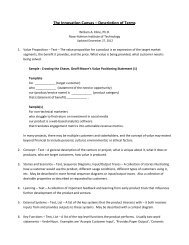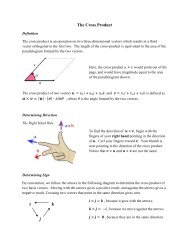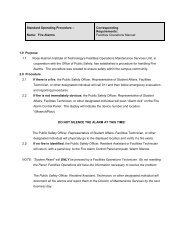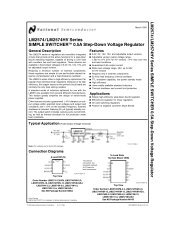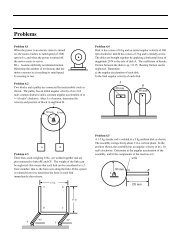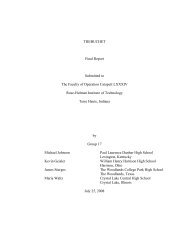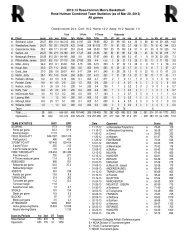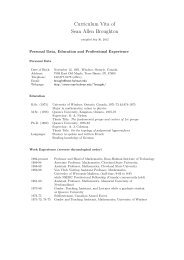21 Photosynthesis (Carbon Assimilation) The light ... - Rose-Hulman
21 Photosynthesis (Carbon Assimilation) The light ... - Rose-Hulman
21 Photosynthesis (Carbon Assimilation) The light ... - Rose-Hulman
Create successful ePaper yourself
Turn your PDF publications into a flip-book with our unique Google optimized e-Paper software.
<strong>Photosynthesis</strong> (<strong>Carbon</strong> <strong>Assimilation</strong>)<br />
<strong>The</strong> <strong>light</strong> reactions result in the formation of the high-energy compounds ATP and<br />
NADPH. While these compounds can be used to drive metabolic processes, one<br />
additional critical reaction must occur: the fixation of carbon dioxide. Without CO 2<br />
fixation, the respiratory processes necessary to generate energy at night would<br />
result in an irreversible conversion of carbon compounds to CO 2 . In addition, carbon<br />
fixation is required to provide energy to non-photosynthetic tissues within the<br />
plant, and to supply the raw material required for growth of the plant.<br />
Animals lack the ability to perform net carbon dioxide fixation; reactions such as<br />
the pyruvate carboxylase reaction only result in temporary increases in the number<br />
of carbon atoms in the compound. 7 Plants, however, have the capability of using the<br />
energy obtained from <strong>light</strong> to drive the permanent incorporation of carbon dioxide<br />
into structural molecules. <strong>The</strong> process for fixing and assimilating carbon is called<br />
the Calvin cycle in honor of the 1961 Nobel Laureate Melvin Calvin.<br />
Overview of the Calvin cycle<br />
<strong>The</strong> Calvin cycle begins with the five-carbon carbohydrate ribulose-1,5-<br />
bisphosphate.<br />
Ribulose-<br />
1,5-Bisphosphate<br />
Regeneration<br />
Ribulose<br />
5-Phosphate<br />
Kinase<br />
Ribulose<br />
5-Phosphate<br />
ATP<br />
ADP<br />
Ribulose<br />
1,5-Bisphosphate<br />
CO 2<br />
Ribulose<br />
1,5-Bisphosphate<br />
carboxylase/oxygenase<br />
(RuBisCO)<br />
3-Phosphoglycerate<br />
(x2)<br />
<strong>Carbon</strong> fixation<br />
ATP<br />
(x2)<br />
Phosphoglycerate<br />
kinase<br />
ADP<br />
(x2)<br />
1,3-Bisphosphoglycerate<br />
(x2)<br />
NADPH<br />
(x2)<br />
Several<br />
Hexose<br />
Monosphosphate<br />
Pathway-like<br />
Reactions<br />
Glyceraldehyde<br />
3-Phosphate<br />
(x2)<br />
NADP<br />
(x2)<br />
Glyceraldehyde<br />
3-Phosphate<br />
Dehydrogenase<br />
<strong>Carbon</strong> assimilation<br />
Ribulose-1,5-bisphosphate acts as the carbon dioxide acceptor; following carbon<br />
dioxide addition, the resulting six-carbon compound is cleaved into two three-carbon<br />
3-phosphoglycerate molecules. <strong>The</strong> 3-phosphoglycerate is then converted to<br />
7 <strong>The</strong> pyruvate carboxylase reaction is the formation of the four-carbon oxaloacetate from the threecarbon<br />
pyruvate. Oxaloacetate may remain in the TCA cycle, or may be used for biosynthetic<br />
processes. When used for biosynthetic processes such as gluconeogenesis, the oxaloacetate loses the<br />
additional carbon. However, even carbon dioxide added to oxaloacetate that remains in the TCA<br />
cycle is effectively only fixed temporarily.<br />
Copyright © 2010-2011 by Mark Brandt, Ph.D.<br />
<strong>21</strong>
glyceraldehyde-3-phosphate using energy obtained from the <strong>light</strong> reactions of<br />
photosynthesis. <strong>The</strong> glyceraldehyde-3-phosphate has several possible fates;<br />
however, the continuation of the carbon fixation process requires regenerating the<br />
ribulose-1,5-bisphosphate starting material. <strong>The</strong> cycle thus has three phases:<br />
carbon fixation, glyceraldehyde-3-phosphate formation and ribulose-1,5-<br />
bisphosphate regeneration.<br />
Rubisco<br />
<strong>The</strong> rate-limiting enzyme in the Calvin cycle is ribulose 1,5-bisphosphate<br />
carboxylase/oxygenase (better known as rubisco). In most plants, rubisco is a<br />
complex of 8 large (53 kDa) and 8 small (14 kDa) subunits ( 8 8 ). <strong>The</strong> large subunit<br />
is coded by a chloroplast gene, while the small subunit gene is located in the<br />
nucleus. In photosynthetic bacteria, rubisco is usually a dimer of proteins<br />
homologous to the plant large subunit.<br />
Rubisco is an intensively studied protein, because it is one of the most important<br />
enzymes in existence. Rubisco is present at a concentration of ~250 mg/ml in the<br />
chloroplast stroma, comprising ~50% of the total chloroplast protein. Plants<br />
production of rubisco exceeds that of any other enzyme, and probably any other<br />
protein, on earth. Current estimates suggest that the biosphere contains ~10 kg of<br />
rubisco per human (this works out to about 0.02 moles of the enzyme per person).<br />
This tremendous amount of protein is necessary because the catalytic efficiency of<br />
rubisco is fairly low: it has a k cat of 1 to 3 sec -1 , and a rather low affinity for carbon<br />
dioxide. It is also necessary because rubisco catalyzes the wasteful oxygenase side<br />
reaction (discussed later); fixing sufficient carbon to support growth requires large<br />
amounts of this enzyme.<br />
<strong>The</strong> rubisco reaction is moderately complex. <strong>The</strong> general reaction mechanism is<br />
shown below.<br />
O<br />
H<br />
H<br />
O<br />
H 2 C<br />
C<br />
C<br />
C<br />
H 2 C<br />
O<br />
O<br />
P<br />
O<br />
OH<br />
OH<br />
O<br />
P<br />
O<br />
O<br />
O<br />
Ribulose<br />
1,5-bisphosphate<br />
H<br />
O<br />
H<br />
O<br />
H 2 C<br />
C<br />
C<br />
C<br />
H 2 C<br />
O<br />
O<br />
P<br />
O<br />
OH<br />
OH<br />
O<br />
P<br />
O<br />
O<br />
O<br />
Enediol<br />
intermediate<br />
H<br />
+<br />
O C O<br />
O<br />
O<br />
H 2 C O<br />
O P O<br />
O P O<br />
H C OH<br />
H 2 C O<br />
H 2 O<br />
H 2 C O<br />
C O<br />
O<br />
O<br />
HO C C HO C C<br />
O<br />
O O 3-Phosphoglycerate<br />
C O<br />
HO C OH<br />
H C OH<br />
H C OH<br />
O<br />
H 2 C O<br />
H 2 C O<br />
C O<br />
O<br />
P<br />
O<br />
O<br />
-Ketoacid<br />
intermediate<br />
O<br />
P<br />
O<br />
O<br />
Hydrated<br />
intermediate<br />
H<br />
C<br />
H 2 C<br />
O<br />
OH<br />
O<br />
P<br />
O<br />
O<br />
3-Phosphoglycerate<br />
<strong>The</strong> enzyme has a basic residue that abstracts a proton from the 3-position carbon<br />
of the ribulose-1,5-bisphosphate substrate, producing the enzyme-bound ene-diol<br />
intermediate. <strong>The</strong> ene-diol acts as the carbon dioxide acceptor, with the carbon<br />
dioxide molecule forming a bond to the 2-position carbon. <strong>The</strong> six-carbon -ketoacid<br />
intermediate is then attacked by a water molecule, resulting in cleavage of the bond<br />
between the former 2-position and 3-position carbons of the ribulose-1,5-<br />
O<br />
O<br />
P<br />
O<br />
Copyright © 2010-2011 by Mark Brandt, Ph.D.<br />
22
isphosphate molecule. This results in the release of two 3-phosphoglycerate<br />
molecules (one of which, as released, contains a negatively charged carbon ion<br />
which then obtains a proton from the aqueous solvent).<br />
<strong>The</strong> overall reaction is therefore:<br />
Ribulose 1,5-bisphosphate + CO 2 + H 2 O 2x 3-phosphoglycerate + 2 H +<br />
<strong>The</strong> rubisco reaction thus yields two triose phosphate molecules from the single<br />
pentose bisphosphate. Note that ATP is not required for the rubisco reaction, a<br />
property that differs from most other carboxylase reactions; in this case, the<br />
reaction has a large negative G° because of the release of the two triose<br />
phosphates.<br />
<strong>Carbon</strong> assimilation reactions<br />
<strong>The</strong> carbon-fixing rubisco reaction thus results in the release of 2 three-carbon 3-<br />
phosphoglycerate molecules. <strong>The</strong> 3-phosphoglycerate molecules are converted to 1,3-<br />
bisphosphoglycerate by phosphoglycerate kinase; this reaction requires ATP as a<br />
phosphate donor. <strong>The</strong> 1,3-bisphosphoglycerate is then converted to glyceraldehyde-<br />
3-phosphate by glyceraldehyde-3-phosphate dehydrogenase.<br />
<strong>The</strong>se two reactions use chloroplast isozymes of the glycolytic enzymes<br />
phosphoglycerate kinase and glyceraldehyde-3-phosphate dehydrogenase (note that<br />
the glyceraldehyde-3-phosphate dehydrogenase uses NADPH as a substrate rather<br />
than NADH). Because two 3-phosphoglycerate molecules are released by rubisco,<br />
two ATP and two NADPH are required to convert all of the triose phosphate to<br />
glyceraldehyde-3-phosphate. <strong>The</strong> ATP and NADPH required are produced by the<br />
<strong>light</strong> reactions, which therefore drive the entire process.<br />
O<br />
H<br />
H<br />
O<br />
H 2 C<br />
C<br />
C<br />
C<br />
H 2 C<br />
O<br />
O<br />
P<br />
O<br />
OH<br />
OH<br />
O<br />
P<br />
O<br />
O<br />
O<br />
Ribulose<br />
1,5-bisphosphate<br />
H 2 O<br />
+ CO 2<br />
Rubisco<br />
2 x<br />
3-Phosphoglycerate<br />
H<br />
O<br />
C<br />
C<br />
CH 2 O<br />
O<br />
O<br />
OH<br />
P<br />
O<br />
O<br />
2 x ATP 2 x ADP<br />
Phosphoglycerate<br />
kinase<br />
O<br />
H<br />
O<br />
P<br />
O<br />
C<br />
C<br />
O<br />
O<br />
OH<br />
CH 2 O<br />
O<br />
P<br />
O<br />
2 x<br />
NADPH<br />
O<br />
2 x<br />
1,3-Bisphosphoglycerate<br />
Glyceraldehyde-<br />
3-phosphate<br />
dehydrogenase<br />
2 x NADP<br />
+<br />
2 x P i<br />
H C<br />
H<br />
C<br />
O<br />
OH<br />
CH 2 O<br />
O<br />
P<br />
O<br />
O<br />
2 x<br />
Glyceraldehyde<br />
3-phosphate<br />
<strong>The</strong> phosphoglycerate kinase and glyceraldehyde-3-phosphate dehydrogenase<br />
reactions are reversible. In chloroplasts exposed to <strong>light</strong> and carbon dioxide, these<br />
reactions result in glyceraldehyde-3-phosphate formation due to the high<br />
concentrations of ATP, NADPH, and 3-phosphoglycerate.<br />
Copyright © 2010-2011 by Mark Brandt, Ph.D.<br />
23
Regeneration of ribulose-1,5-bisphosphate<br />
Glyceraldehyde-3-phosphate can be converted to glucose without further input of<br />
energy. However, unless the ribulose 1,5-bisphosphate is regenerated the rubisco<br />
reaction will be unable to continue.<br />
<strong>The</strong> carbon assimilation process begins with three ribulose 1,5-bisphosphate<br />
(containing a total of 15 carbons); it ends with six glyceraldehyde-3-phosphate<br />
(containing a total of 18 carbons), a net gain of three carbons from carbon dioxide.<br />
Assuming that five triose phosphates are used to regenerate the starting ribulose<br />
1,5-bisphosphate, the remaining triose phosphate can then be diverted to other<br />
processes.<br />
<strong>The</strong> regeneration process uses enzymes related to those of the hexose<br />
monophosphate pathway. Three-carbon units in the form of glyceraldehyde-3-<br />
phosphate or dihydroxyacetone phosphate enter the pathway in a total of five<br />
places. <strong>The</strong> result of the pathway is the formation of three ribulose 1,5-bisphosphate<br />
molecules from the five trioses.<br />
<br />
<br />
<br />
<br />
<br />
<br />
<br />
<br />
<br />
<br />
<br />
<br />
<br />
<br />
<br />
<br />
<br />
<br />
<br />
<br />
<br />
<br />
<br />
<br />
<br />
<br />
<br />
<br />
<br />
<br />
<br />
<br />
<br />
<br />
<br />
<br />
<br />
<br />
<br />
<br />
<br />
<br />
<br />
<br />
<br />
<br />
<br />
<br />
<br />
<br />
<br />
<br />
<br />
<br />
<br />
<br />
Copyright © 2010-2011 by Mark Brandt, Ph.D.<br />
24
Three irreversible steps, fructose bisphosphatase, sedoheptulose bisphosphatase,<br />
and ribulose-5-phosphate kinase make the regeneration pathway irreversible. Note<br />
that the regeneration pathway only uses five trioses; this means that the sixth<br />
triose formed can be used for other purposes. Animals lack rubisco,<br />
sedoheptulose bisphosphatase, and ribulose-5-phosphate kinase, and therefore are<br />
incapable of the carbon assimilation reactions (in addition to lacking the requisite,<br />
non-metabolic, energy source).<br />
Glyceraldehyde-3-phosphate and dihydroxyacetone phosphate are effectively<br />
interchangeable due to the action of the reversible glycolytic enzyme triose<br />
phosphate isomerase. Glyceraldehyde-3-phosphate and dihydroxyacetone phosphate<br />
can be combined in an aldol condensation reaction by transaldolase (an isozyme of<br />
the glycolytic aldolase) to produce fructose-1,6-bisphosphate. <strong>The</strong> fructose-1,6-<br />
bisphosphate is then converted to fructose-6-phosphate by fructose<br />
bisphosphatase, the first irreversible enzyme in the pathway.<br />
<strong>The</strong> fructose-6-phosphate then acts as a substrate for transketolase.<br />
Transketolase is a thiamin pyrophosphate-dependent enzyme that catalyzes twocarbon<br />
transfer reactions. In this case, it transfers two carbons from fructose-6-<br />
phosphate to glyceraldehyde-3-phosphate, yielding the four-carbon erythrose-4-<br />
phosphate, and the five-carbon xylulose-5-phosphate. Ribulose-5-phosphate<br />
epimerase converts the xylulose-5-phosphate to the first of the ribulose-5-phosphate<br />
molecules produced by the regeneration pathway.<br />
<strong>The</strong> erythrose-4-phosphate, an aldotetrose, acts as a substrate for another<br />
transaldolase reaction, condensing with dihydroxyacetone phosphate to form the<br />
seven-carbon compound sedoheptulose-1,7-bisphosphate. (Note that the<br />
transaldolase reactions of the regeneration pathway both result in bisphosphate<br />
carbohydrates.) Sedoheptulose bisphosphatase catalyzes the second irreversible<br />
reaction of the regeneration pathway, releasing sedoheptulose-7-phosphate.<br />
<strong>The</strong> sedoheptulose-7-phosphate acts as a substrate for a second transketolase<br />
reaction, combining with the final glyceraldehyde-3-phosphate to yield two pentose<br />
phosphates: ribose-5-phosphate, and a second xylulose-5-phosphate. Both of these<br />
pentose phosphates are then converted to ribulose-5-phosphate molecules.<br />
<strong>The</strong> pathway produces a total of three ribulose-5-phosphate from the five triose<br />
phosphates. Ribulose-5-phosphate kinase catalyzes the final irreversible step of the<br />
regeneration pathway, the ATP-dependent phosphorylation of ribulose-5-phosphate<br />
to produce the rubisco substrate, ribulose-1,5-bisphosphate.<br />
<strong>The</strong> net reaction of running the Calvin cycle to produce one excess triose phosphate<br />
(in the form of glyceraldehyde-3-phosphate is:<br />
6 NADPH + 3 CO 2 + 9 ATP + 6 H 2 O glyceraldehyde-3-phosphate + 9 ADP + 8 P i<br />
+ 6 NADP<br />
<strong>The</strong> <strong>light</strong> reactions produce roughly three ATP for every two NADPH; thus, in<br />
Copyright © 2010-2011 by Mark Brandt, Ph.D.<br />
25
principle, one complete oxygen-evolving <strong>light</strong> reaction results in fixation of one<br />
molecule of carbon dioxide. In practice, however, some ATP and NADPH are used<br />
for other purposes, and therefore the <strong>light</strong> reactions and carbon assimilation<br />
reactions are not always stoichiometrically coupled.<br />
Side Note: <strong>The</strong> transketolase reaction<br />
<strong>The</strong> enzyme transketolase contains a thiamin pyrophosphate cofactor. As in most enzymes that use<br />
this cofactor, in transketolase, the thiamin pyrophosphate cofactor becomes transiently covalently<br />
modified during the reaction. In transketolase the two-carbon unit is removed from the ketose (in the<br />
example below, from xylulose-5-phosphate) and given to the aldose acceptor (in the example, to<br />
ribose-5-phosphate). <strong>The</strong> reaction generates an aldehyde in the remaining portion of the donor<br />
molecule, and maintains the ketone originally present in the transferred two-carbon unit.<br />
H 2 C<br />
OH<br />
H<br />
O<br />
C<br />
O<br />
O<br />
P<br />
O<br />
O<br />
H<br />
H<br />
H<br />
O<br />
C<br />
C<br />
C<br />
C<br />
CH 2<br />
Ribose-<br />
5-phosphate<br />
OH<br />
OH<br />
OH<br />
+<br />
O<br />
O<br />
P<br />
O<br />
O<br />
HO<br />
H<br />
O<br />
H 2 C<br />
Xylulose-<br />
5-phosphate<br />
C<br />
C<br />
C<br />
CH 2<br />
OH<br />
H<br />
OH<br />
Transketolase<br />
[TPP]<br />
O<br />
O<br />
P<br />
O<br />
HO<br />
H<br />
H<br />
H<br />
O<br />
C<br />
C<br />
C<br />
C<br />
CH 2<br />
H<br />
OH<br />
OH<br />
OH<br />
Sedoheptulose-<br />
7-phosphate<br />
+<br />
O<br />
O<br />
P<br />
O<br />
H<br />
O<br />
H<br />
C<br />
C<br />
CH 2<br />
OH<br />
O<br />
Glyceraldehyde-<br />
3-phosphate<br />
Utilization of assimilated carbon<br />
<strong>The</strong> excess trioses produced have several possible fates. <strong>The</strong>se fates must involve<br />
release of phosphate from the carbohydrate, otherwise phosphate becomes limiting.<br />
(Light allows carbon fixation, but does not increase the amount of phosphate<br />
present.)<br />
1) Starch production: Starch is an energy storage form of glucose. <strong>The</strong> starch<br />
produced and stored within the chloroplast acts as an energy source to maintain<br />
metabolism during the night.<br />
Starch is a mixture of amylose, a<br />
linear -1,4-glucose polymer and<br />
amylopectin, an -1,4-glucose<br />
polymer with -1,6 branches.<br />
Amylopectin differs from glycogen<br />
only in having fewer branch points.<br />
<strong>The</strong> diagram at right shows the<br />
structural features of the glucose<br />
polymers.<br />
HO<br />
OH<br />
OH<br />
HO<br />
CH 2<br />
OH<br />
O<br />
OH<br />
O<br />
2<br />
OHCH<br />
O<br />
OH<br />
O<br />
OH<br />
-1,6-Glucoside<br />
bond<br />
CH 2<br />
O<br />
OH<br />
HO<br />
O<br />
CH 2<br />
OH<br />
-1,4-Glucoside bond<br />
Starch (amylopectin)<br />
(-1,4-glucoside polymer<br />
with -1,6-glucoside<br />
branches)<br />
O<br />
OH<br />
HO<br />
O<br />
CH 2<br />
OH<br />
O<br />
OH<br />
n<br />
<strong>The</strong> starch synthetic system is generally similar to glycogen synthesis in animals.<br />
However, the starch synthase uses ADP-glucose rather than UDP-glucose as the<br />
Copyright © 2010-2011 by Mark Brandt, Ph.D.<br />
26
glucose donor.<br />
Production of starch is regulated primarily by ADP-glucose pyrophosphorylase,<br />
which acts as the control point and rate-limiting step for starch synthesis. <strong>The</strong><br />
enzyme uses ATP and glucose-1-phosphate as substrates, yielding ADP-glucose and<br />
pyrophosphate as products. <strong>The</strong> reaction is reversible, with pyrophosphate<br />
hydrolysis acting as the driving force. <strong>The</strong> ADP-glucose produced acts as a substrate<br />
for the starch synthase that adds the glucose unit to the growing starch chain. ADPglucose<br />
pyrophosphorylase is allosterically regulated; in most plants it is stimulated<br />
by 3-phosphoglycerate (an indicator that the cell is actively fixing carbon) and is<br />
inhibited by phosphate (which is elevated when ATP levels are low).<br />
<strong>The</strong> synthesis of starch from triose phosphates is summarized in the chart below.<br />
Triose phosphate<br />
H C O<br />
isomerase H<br />
H C OH<br />
Dihydroxyacetone<br />
HO C H<br />
phosphate<br />
CH 2 O<br />
O C<br />
Glyceraldehyde<br />
O P O<br />
3-phosphate CH 2 O<br />
O<br />
O P O<br />
O<br />
Fructose- O<br />
1,6-bisphosphate<br />
Transaldolase<br />
O P O CH 2 O<br />
OH<br />
HO<br />
O<br />
CH 2 O P O<br />
OH<br />
O<br />
O<br />
Fructose<br />
bisphosphatase<br />
Glucose-6-phosphate<br />
O Fructose-6-phosphate<br />
O<br />
O<br />
P O CH 2<br />
O P O CH 2 O CH 2 OH<br />
O<br />
O<br />
HO<br />
OH<br />
OH<br />
Phosphoglucoisomerase OH<br />
OH<br />
O<br />
OH<br />
OH<br />
HO CH 2<br />
OH<br />
OH<br />
O<br />
OH<br />
HO CH 2<br />
O<br />
OH<br />
O<br />
OH<br />
Starch<br />
HO CH 2<br />
OH<br />
O<br />
O<br />
OH<br />
n<br />
ADP<br />
Starch<br />
synthase<br />
HO CH 2<br />
OH<br />
OH<br />
HO CH 2<br />
OH<br />
OH<br />
ADP-Glucose<br />
O<br />
OH O<br />
O P O P O<br />
OH<br />
O O<br />
HO CH 2<br />
O<br />
O<br />
OH<br />
O<br />
OH<br />
OH n<br />
P i<br />
O P<br />
N<br />
NH 2<br />
N<br />
CH 2 O<br />
OH<br />
Pyrophosphate<br />
O<br />
N<br />
N<br />
OH<br />
O<br />
P<br />
O<br />
O<br />
O<br />
P<br />
O<br />
O<br />
O<br />
O<br />
P<br />
O<br />
Adenosine<br />
Triphosphate<br />
(ATP)<br />
O<br />
O<br />
O<br />
O<br />
ADP-glucose<br />
pyrophosphorylase<br />
P<br />
O<br />
P<br />
O<br />
O<br />
N<br />
CH 2<br />
OH<br />
NH 2<br />
N<br />
O<br />
N<br />
N<br />
OH<br />
HO CH 2<br />
OH<br />
Phosphoglucomutase<br />
O<br />
OH<br />
OH<br />
OH<br />
OH<br />
O<br />
-Glucose-1-Phosphate<br />
2) Triose Export: Utilization of the fixed carbon requires translocation of the triose<br />
phosphate molecules synthesized from the chloroplast to the cytoplasm. This<br />
process is performed by a phosphate/triose phosphate antiport located in the<br />
chloroplast inner membrane. Dihydroxyacetone phosphate produced in the carbon<br />
assimilation reactions leaves the chloroplast in exchange for phosphate (which is<br />
required for the synthesis of additional triose phosphates). <strong>The</strong> cytoplasmic<br />
phosphate is released from the carbohydrate during both glycolysis and sucrose<br />
synthesis (note that neither pyruvate nor sucrose contain phosphate).<br />
<strong>The</strong> triose transporter can also be used as part of a shuttle system for moving ATP<br />
and reducing equivalents generated during the <strong>light</strong> reactions out of the chloroplast.<br />
<strong>The</strong> ATP and reduced nicotinamide cofactors can then be used to support<br />
Copyright © 2010-2011 by Mark Brandt, Ph.D.<br />
27
metabolism in the other parts of the cell. To allow this, dihydroxyacetone phosphate<br />
leaves the chloroplast in exchange for phosphate (as above). However, the<br />
dihydroxyacetone phosphate is converted to 3-phosphoglycerate using the glycolytic<br />
enzymes triose phosphate isomerase, glyceraldehyde-3-phosphate dehydrogenase,<br />
and phosphoglycerate kinase. <strong>The</strong>se reactions generate NADH and ATP in the<br />
cytoplasm. <strong>The</strong> 3-phosphoglycerate produced then re-enters the chloroplast using<br />
the phosphate/triose phosphate antiport, and is reconverted to dihydroxyacetone<br />
phosphate using the enzymes of the carbon assimilation pathway.<br />
Glycolysis<br />
Sucrose synthesis<br />
Dihydroxyacetone<br />
phosphate<br />
Triose phosphate<br />
isomerase<br />
P i<br />
Triose phosphate/Phosphate<br />
Exchanger<br />
Dihydroxyacetone<br />
phosphate<br />
P i<br />
Triose phosphate<br />
isomerase<br />
NAD<br />
+ P i NADH ADP ATP<br />
1,3-Bisphosphoglyceratglycerate<br />
3-Phospho-<br />
Glyceraldehyde<br />
Phosphoglycerate<br />
3-phosphate<br />
kinase<br />
dehydrogenase<br />
P i<br />
Cytosol<br />
Triose phosphate/Phosphate<br />
Chloroplast Inner Membrane<br />
Exchanger<br />
Stroma<br />
P i<br />
Glyceraldehyde<br />
3-phosphate<br />
Phosphoglycerate<br />
dehydrogenase<br />
1,3-Bisphosphoglyceratglycerate<br />
kinase 3-Phospho-<br />
NADP NADPH<br />
ADP ATP<br />
+ P i<br />
Glyceraldehyde<br />
3-phosphate<br />
Glyceraldehyde<br />
3-phosphate<br />
<strong>The</strong> shuttle system can therefore be used to move ATP and reducing equivalents,<br />
without using carbon compounds; alternatively, the dihydroxyacetone phosphate<br />
can leave the chloroplast, with only phosphate returning.<br />
3) Sucrose synthesis: Sucrose is a non-reducing (and therefore chemically less<br />
reactive) disaccharide of fructose and glucose used<br />
HO CH<br />
to transport energy from photosynthetic<br />
2 -D-Glucopyranosyl<br />
O<br />
apparatus to non-photosynthetic cells. Production OH<br />
of sucrose occurs in the cytoplasm.<br />
As with starch production, sucrose synthesis is<br />
regulated by availability of triose phosphates. <strong>The</strong><br />
relative levels of starch and sucrose production<br />
are tightly regulated to prevent the<br />
photosynthetic cell from depleting its energy<br />
stores.<br />
HO<br />
OH<br />
CH 2<br />
OH<br />
O<br />
OH<br />
HO<br />
O<br />
Sucrose<br />
(1--D-glucopyranosido-<br />
-D-fructofuranoside<br />
CH 2 OH<br />
-D-Fructofuranoside<br />
Copyright © 2010-2011 by Mark Brandt, Ph.D.<br />
28
4) Glycolysis: Plants, like all eukaryotic cells, contain mitochondria; some of the<br />
triose phosphates generated during photosynthesis (or at night during starch<br />
breakdown) are used in the cytoplasm and mitochondria for generation of energy<br />
and biosynthetic intermediates. <strong>The</strong> glycolytic and TCA cycle pathways of plants<br />
are similar to those of animals.<br />
Regulation of carbon assimilation<br />
Unless ATP and NADPH generated by the <strong>light</strong> reactions is available, the rubisco<br />
reaction and the other carbon assimilation reactions merely waste energy to no<br />
useful purpose. <strong>The</strong>refore, several of the Calvin cycle enzymes are tightly regulated<br />
to prevent the cycle in the absence of <strong>light</strong>. (In other words the so-called “dark<br />
reactions” do not occur in the dark.)<br />
<strong>The</strong> regulation of rubisco occurs at several steps. <strong>The</strong> free rubisco enzyme has a<br />
high affinity for ribulose-1,5-bisphosphate but is inactive. In order to become<br />
activated, carbon dioxide must bind to a critical lysine residue (Lys 201 of the large<br />
subunit); the presence of ribulose-1,5-bisphosphate in the binding site prevents this<br />
from happening. Removal of the ribulose-1,5-bisphosphate requires an ATPhydrolysis<br />
dependent enzyme, rubisco activase, which catalyzes the release of<br />
ribulose-1,5-bisphosphate and the covalent modification of Lys 201 .<br />
<strong>The</strong> carbamate derivative of rubisco requires Mg 2+ for activity (it is thought that<br />
the cation is required to stabilize the charges that develop on some of the reaction<br />
intermediates). <strong>The</strong> concentration of Mg 2+ in the stroma increases during the <strong>light</strong><br />
reactions, because the thylakoid lumen releases Mg 2+ when the internal proton<br />
concentration is high (i.e. when protons are pumped into the lumen during the <strong>light</strong><br />
reactions). Proton pumping also increases pH of the stroma to ~8; rubisco is most<br />
active at this pH.<br />
Ribulose-1,5-<br />
bisphosphate<br />
+<br />
O<br />
C O<br />
ADP<br />
NH 3 ATP<br />
NH<br />
+ P 3 NH<br />
i<br />
Lys 201 CO 2<br />
Lys 201<br />
Rubisco<br />
Rubisco<br />
Rubisco<br />
(Free enzyme)<br />
activase<br />
Lys 201<br />
Rubisco<br />
bound to<br />
ribulose-1,5-<br />
bisphosphate<br />
Inactive<br />
(Carbamate<br />
derivative)<br />
Mg 2+<br />
O Mg 2+<br />
C O<br />
NH<br />
Lys 201<br />
Rubisco<br />
(Mg 2+ /Carbamate<br />
derivative)<br />
Active<br />
Although the carbamate derivative of rubisco is potentially active, it is also<br />
regulated by an endogenous inhibitor. 2-Carboxyarabinitol 1-phosphate is related to<br />
the -ketoacid intermediate of the rubisco reaction, and binds to rubisco with high<br />
affinity. 2-Carboxyarabinitol 1-phosphate is synthesized in the dark and broken<br />
down in response to <strong>light</strong> by other enzymes.<br />
Copyright © 2010-2011 by Mark Brandt, Ph.D.<br />
29
O<br />
O<br />
O<br />
P<br />
O<br />
O<br />
P<br />
O<br />
O<br />
O<br />
HO<br />
H<br />
H<br />
CH 2<br />
O<br />
C C<br />
O<br />
C OH<br />
C<br />
H 2 C<br />
OH<br />
OH<br />
2-Carboxyarabinitol-<br />
1-phosphate<br />
CH 2<br />
O<br />
HO C C<br />
O<br />
C O<br />
H C OH<br />
H 2 C O<br />
O P O<br />
O<br />
-Ketoacid<br />
intermediate<br />
Thus, rubisco is inactive: 1) when bound to an inhibitor, 2) when bound to its<br />
ribulose-1,5-bisphosphate substrate if the enzyme is not covalently modified by<br />
carbon dioxide, and 3) in the absence of Mg 2+ .<br />
Rubisco is active: 1) when Lys 201 is carbamoylated, 2) when bound to Mg 2+ , 3)<br />
when 2-Carboxyarabinitol 1-phosphate has been degraded by <strong>light</strong>-dependent<br />
enzymes, and 4) under the conditions of elevated pH that occur when the<br />
chloroplast is exposed to <strong>light</strong>.<br />
Fructose bisphosphatase and sedoheptulose bisphosphatase, two of the<br />
irreversible enzymes of the regeneration pathway are also stimulated by elevated<br />
pH and elevated Mg 2+ concentration. In addition, these enzymes contain a pair of<br />
cysteine residues that are critical for activity. In the absence of <strong>light</strong>, the enzymes<br />
become oxidized, and form a disulfide bond between the cysteine side-chains.<br />
Illumination of the chloroplast results in reduction of the soluble ferredoxin (a<br />
protein found in the electron transport chain involved in NADPH production).<br />
Reduced ferredoxin can donate electrons to thioredoxin (a process catalyzed by<br />
thioredoxin reductase). <strong>The</strong> reduced thioredoxin then reduces the disulfide bonds of<br />
fructose bisphosphatase and sedoheptulose bisphosphatase to free sulfhydryl groups<br />
in order to activate these enzymes. <strong>The</strong>se enzymes are therefore activated indirectly<br />
by <strong>light</strong>.<br />
Photorespiration<br />
Rubisco, in addition to its critically important carboxylase activity, is capable of<br />
using oxygen as a substrate in place of carbon dioxide. This results in oxygenase<br />
activity (hence the “o” in the word “rubisco”). <strong>The</strong> product of the oxygenase activity<br />
must then be converted back to Calvin cycle intermediates by the poorly named<br />
“photorespiration pathway”.<br />
Copyright © 2010-2011 by Mark Brandt, Ph.D.<br />
30
CO 2<br />
+ ADP<br />
ATP<br />
+ O 2<br />
Ribulose-<br />
1,5-Bisphosphate<br />
Regeneration<br />
Ribulose<br />
5-Phosphate<br />
Kinase<br />
Ribulose<br />
5-Phosphate<br />
ATP<br />
ADP<br />
Ribulose<br />
1,5-Bisphosphate<br />
Rubisco<br />
(oxygenase)<br />
O 2<br />
CO 2<br />
3-Phosphoglycerate<br />
+<br />
Phosphoglycolate<br />
Rubisco<br />
(carboxylase)<br />
3-Phosphoglycerate<br />
(x2)<br />
Photorespiration<br />
<strong>Carbon</strong> fixation<br />
ATP<br />
(x2)<br />
Phosphoglycerate<br />
kinase<br />
ADP<br />
(x2)<br />
1,3-Bisphosphoglycerate<br />
(x2)<br />
NADPH<br />
(x2)<br />
Several<br />
Hexose<br />
Monosphosphate<br />
Pathway-like<br />
Reactions<br />
Glyceraldehyde<br />
3-Phosphate<br />
(x2)<br />
NADP<br />
(x2)<br />
Glyceraldehyde<br />
3-Phosphate<br />
Dehydrogenase<br />
<strong>Carbon</strong> assimilation<br />
<strong>The</strong> rubisco oxygenase activity results in the formation of a molecule of the twocarbon<br />
compound phosphoglycolate and a molecule of 3-phosphoglycerate.<br />
O<br />
H<br />
H<br />
O<br />
H 2 C<br />
C<br />
C<br />
C<br />
H 2 C<br />
O<br />
O<br />
P<br />
O<br />
OH<br />
OH<br />
O<br />
P<br />
O<br />
O<br />
O<br />
Ribulose<br />
1,5-bisphosphate<br />
H<br />
O<br />
H<br />
O<br />
H 2 C<br />
C<br />
C<br />
C<br />
H 2 C<br />
O<br />
O<br />
P<br />
O<br />
OH<br />
OH<br />
O<br />
P<br />
O<br />
O<br />
O<br />
Enediol<br />
intermediate<br />
O<br />
H<br />
O P O<br />
O<br />
+ H 2 C O<br />
H 2 C<br />
O O<br />
HO C O OH<br />
C<br />
C O<br />
O<br />
H<br />
C<br />
H 2 C<br />
O<br />
OH<br />
O<br />
P<br />
O<br />
O<br />
Hydroperoxy<br />
intermediate<br />
H<br />
O<br />
C<br />
C<br />
H 2 C<br />
O<br />
O<br />
P<br />
O<br />
O<br />
O<br />
O<br />
OH<br />
O<br />
P<br />
O<br />
O<br />
3-Phosphoglycerate<br />
Phosphoglycolate<br />
Copyright © 2010-2011 by Mark Brandt, Ph.D.<br />
31
<strong>The</strong> phosphoglycolate produced must be converted to 3-phosphoglycerate by the<br />
photorespiration pathway. <strong>The</strong> process is called photorespiration because it results<br />
in oxygen consumption and carbon dioxide production; in effect it uses energy to run<br />
the rubisco reaction in reverse. Photorespiration uses several different<br />
compartments, and requires glycine as a pseudo-coenzyme (the glycine carbon<br />
effectively comes from phosphoglycolate, but the amino group nitrogen is lost). In<br />
the overall process, two molecules of phosphoglycolate are converted to one molecule<br />
of 3-phosphoglycerate, with loss of nitrogen as ammonia, loss of carbon dioxide, and<br />
the utilization of a molecule of ATP<br />
O<br />
H<br />
H<br />
O<br />
H 2 C<br />
C<br />
C<br />
C<br />
H 2 C<br />
O<br />
O<br />
P<br />
O<br />
OH<br />
OH<br />
O<br />
P<br />
O<br />
O<br />
O<br />
Ribulose<br />
1,5-bisphosphate<br />
O 2<br />
Hydroxypyruvate<br />
Ribulose-<br />
1,5-bisphosphate<br />
carboxylase<br />
oxygenase<br />
Calvin<br />
cycle<br />
H<br />
O<br />
H 2 C<br />
C<br />
O<br />
O<br />
P<br />
O<br />
O<br />
O<br />
Phosphoglycolate<br />
O<br />
C<br />
C<br />
H 2 C<br />
O<br />
O<br />
OH<br />
O<br />
P<br />
O<br />
O<br />
ADP<br />
3-Phosphoglycerate<br />
Chloroplast<br />
Phosphoglycolate<br />
phosphatase<br />
ATP<br />
Glycerate<br />
kinase<br />
H<br />
H 2 C<br />
C<br />
O<br />
OH<br />
O<br />
Glycolate<br />
O<br />
C<br />
C<br />
H 2 C<br />
O<br />
OH<br />
OH<br />
Glycerate<br />
H<br />
H 2 C<br />
C<br />
O<br />
OH<br />
O<br />
Glycolate<br />
O<br />
C<br />
C<br />
H 2 C<br />
O<br />
OH<br />
OH<br />
Glycerate<br />
O 2 H 2 O 2<br />
Glycolate<br />
oxidase<br />
NAD<br />
NADH<br />
-Hydroxyacid<br />
reductase<br />
Peroxisome<br />
HC O<br />
C O<br />
O<br />
Glyoxalate<br />
H 2 C<br />
HO<br />
O<br />
C<br />
C<br />
O<br />
O<br />
Serine<br />
aminotransferase<br />
H 2 C<br />
HO<br />
NH 3<br />
CH 2<br />
CH 2<br />
C O<br />
O<br />
Glycine<br />
NH 3<br />
CH<br />
C<br />
O<br />
O<br />
Serine<br />
NH 3 NH 3<br />
CH 2<br />
C<br />
O<br />
O<br />
Glycine<br />
NAD<br />
NADH<br />
+ NH 3<br />
+ CO 2<br />
Mitochondrion<br />
H 2 C<br />
HO<br />
+<br />
C<br />
O<br />
O<br />
Glycine<br />
Glycine<br />
decarboxylase<br />
NH 3<br />
CH<br />
C<br />
O<br />
O<br />
Serine<br />
<br />
<br />
<br />
<br />
<br />
Photorespiration is a remarkably wasteful process; both conversion of<br />
phosphoglycolate to 3-phosphoglycerate and regeneration of ribulose-1,5-phosphate<br />
require ATP. <strong>The</strong> energy lost in this process has been estimated to decrease plant<br />
growth by as much as 50%.<br />
<strong>The</strong> purpose of the oxygenase activity of rubisco is not known. However, no<br />
organisms have evolved a rubisco that lacks this oxygenase activity. It is possible<br />
that the oxygenase may act as protection from damaging photooxidation; <strong>light</strong> in<br />
absence of CO 2 appears to result in photooxidation damage to the cell.<br />
Alternatively, the limited specificity of the enzyme may be a vestige of the historical<br />
time period when free oxygen was rare.<br />
<strong>The</strong> mechanistic reason for the oxygenase activity is clear. <strong>The</strong> rubisco K m for CO 2<br />
is ~9 µM, a value that increases with temperature. <strong>The</strong> rubisco K m for O 2 is ~350<br />
µM. Atmospheric partial pressures of oxygen and carbon dioxide result in dissolved<br />
concentrations in water for carbon dioxide of ~11 µM and for oxygen of ~250 µM.<br />
Under normal conditions, the ratio of carbon dioxide to oxygen utilization is roughly<br />
3 to 1. At higher temperatures, the K m for carbon dioxide rises, and the result is<br />
Copyright © 2010-2011 by Mark Brandt, Ph.D.<br />
32
that the oxygenase activity becomes an even larger fraction of the total activity of<br />
rubisco.<br />
Plants that use the pathways discussed above are called C3 plants, to differentiate<br />
them from the rarer C4 types that use a modified pathway intended to decrease<br />
photorespiration. <strong>The</strong> C4 plants temporarily fix carbon dioxide using phosphoenolpyruvate<br />
carboxylase (an enzyme that does not react with oxygen) in mesophyll<br />
cells. <strong>The</strong> phosphoenolpyruvate carboxylase reaction converts phosphoenolpyruvate<br />
to oxaloacetate. <strong>The</strong> oxaloacetate is then converted to malate by malate<br />
dehydrogenase. <strong>The</strong> malate moves to the bundle-sheath cells by passing through<br />
plasmodesmata (structures that function like gap junctions), where malic enzyme<br />
releases the temporarily fixed carbon dioxide. <strong>The</strong> result is a much higher carbon<br />
dioxide concentration in the local environment near the rubisco.<br />
<br />
<br />
<br />
<br />
<br />
<br />
<br />
<br />
<br />
<br />
<br />
<br />
<br />
<br />
<br />
<br />
<br />
<br />
<br />
<br />
<br />
<br />
<br />
<br />
<br />
<br />
<br />
<br />
<br />
<strong>The</strong> pyruvate must be converted back to phosphoenolpyruvate using an unusual<br />
enzyme, pyruvate phosphate dikinase, which uses ATP to phosphorylate both the<br />
pyruvate and an inorganic phosphate (the pyrophosphate produced is then<br />
hydrolyzed to help drive the reaction). <strong>The</strong> C4 pathway thus requires the additional<br />
energy of two ATP equivalents per carbon fixed. However, the reduction in wasted<br />
energy due to lower oxygenase activity (and therefore lower photorespiration)<br />
allows C4 plants to outgrow C3 plants under conditions of high temperature with<br />
intense sun<strong>light</strong>.<br />
C3 plants perform both photorespiration and the normal carbon-fixing Calvin cycle.<br />
C4 plants also perform both photorespiration and an identical carbon-fixing<br />
Calvin cycle. However, by adding an additional (energy-dependent) pathway, and by<br />
creating a spatial separation between the outside of the plant and the carbon<br />
fixation machinery, C4 plants perform much less oxygenase activity than do C3<br />
plants, and therefore are more energy efficient under some conditions.<br />
In C3 plants, most photosynthesis occurs in the mesophyll cells. <strong>The</strong>se cells are<br />
exposed to atmospheric oxygen and carbon dioxide. As a result, rubisco can use<br />
either carbon dioxide or oxygen as substrate, and therefore performs both<br />
carboxylase and oxygenase reactions. At high temperatures, rubisco has reduced<br />
affinity for carbon dioxide. Because the affinity for oxygen does not change<br />
Copyright © 2010-2011 by Mark Brandt, Ph.D.<br />
33
significantly, the reduced affinity for carbon dioxide means that the oxygenase<br />
activity occurs more frequently at high temperatures.<br />
In C4 plants, the mesophyll cell fixes carbon dioxide temporarily by converting the<br />
three-carbon phosphoenolpyruvate to four-carbon oxaloacetate (C4 = four-carbon).<br />
This carbon is then transported to the bundle-sheath cell further inside the plant,<br />
where carbon dioxide is released.<br />
Because carbon dioxide concentration inside the bundle-sheath cell is higher, and<br />
because oxygen concentration is lower than in the mesophyll cell, the rubisco<br />
performs far fewer oxygenase reactions and more carboxylase reactions. This<br />
becomes important at high temperatures.<br />
<br />
<br />
<br />
<br />
<br />
<br />
<br />
<br />
<br />
<br />
<br />
<br />
<br />
<br />
<br />
<br />
<br />
<br />
<br />
<br />
<br />
<br />
<br />
<br />
<br />
<br />
<br />
<br />
<br />
If the rubisco performs only carboxylase activity C4 plants require more energy per<br />
carbon fixed. However, if the C3 plant oxygenase/carboxylase ratio is high (e.g., at<br />
high temperatures), the energy saved by not performing the oxygenase pathway in<br />
C4 plants means that C4 plants may grow faster than C3 plants.<br />
Copyright © 2010-2011 by Mark Brandt, Ph.D.<br />
34
Summary<br />
<strong>The</strong> <strong>light</strong> reactions of photosynthesis store energy in the form of ATP and NADPH.<br />
<strong>The</strong> reactions of the Calvin cycle (sometimes referred to by the historical but<br />
inaccurate title of the dark reactions) use ATP and NADPH to fix and assimilate<br />
carbon dioxide.<br />
<strong>The</strong> initial reaction is catalyzed by ribulose-1,5-bisphosphate carboxylase/oxygenase<br />
(rubisco) which incorporates one molecule of carbon dioxide into the pentose and<br />
releases two 3-phosphoglycerate molecules. <strong>The</strong> 3-phosphoglycerate molecules are<br />
converted to glyceraldehyde-3-phosphate using chloroplast isozymes of the<br />
glycolytic enzymes phosphoglycerate kinase and glyceraldehyde-3-phosphate<br />
dehydrogenase. Some of the glyceraldehyde-3-phosphate is diverted to other<br />
processes (such as starch synthesis, sucrose synthesis, or other forms of<br />
metabolism); the remainder is converted back to ribulose-1,5-bisphosphate by a<br />
series of reactions similar to those in the hexose monophosphate pathway.<br />
<strong>The</strong> Calvin cycle is stimulated by <strong>light</strong>, and is turned off in the dark, because <strong>light</strong><br />
is required to generated the energy required for the carbon assimilation process.<br />
<strong>The</strong> rubisco enzyme catalyzes a wasteful side reaction using oxygen instead of<br />
carbon dioxide, resulting in the photorespiration pathway to regenerate the<br />
ribulose-1,5-bisphosphate substrate. C4 plants have evolved a somewhat more<br />
expensive variant of the Calvin cycle that reduces the oxygenase activity of rubisco.<br />
<strong>The</strong> overall process of photosynthesis uses the energy in <strong>light</strong> to synthesize<br />
carbohydrates, and, in plants, to release oxygen. <strong>The</strong>se processes are required,<br />
directly or indirectly, for the survival of the vast majority of known life forms.<br />
Copyright © 2010-2011 by Mark Brandt, Ph.D.<br />
35





